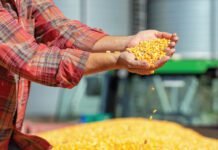Corn for cows
Dr. Mumtaz Cheema of Grenfell Campus, Memorial University Professor and agronomist with his team prepared corn that is meant to become silage corn a version of the grain that is processed into animal feed and to be widely used in island’s dairy industry, where self-sufficient feeding is still more of a dream than reality.
“In Newfoundland and Labrador, farmers can grow and fulfil the feeding requirements for their animals only up to 10 per cent, and the rest they import from mainland Canada. If I am able to produce silage corn, with a high biomass, with good quality traits, i think that will be a big contribution, a big help to the farmers,” said Cheema.
The science behind the stalks
The October harvest is the first in a two-year study to research what corn, and what fertilizers, work best on the island. The project is led by Cheema, but also includes more faculty and researchers at Grenfell Campus’ Boreal Ecosystem Research Initiative, the provincial government, and west coast dairy farmers.
Cheema and his team planted five, carefully chosen varieties of corn on the small, 0.2 hectare test site in Pynn’s Brook back in June. “Because on the island, we don`t have high heating units, so we`re growing low heating unit varieties of corn,” explained Cheema.
A heating unit is a measurement used to quantify the temperature various crops need to grow. Cheema’s corn varieties require between 2000 and 2200 heating units to flourish. To compare – many Ontario varieties typically soak up 3000 heating units.
Throughout the field, there are slim cylindrical tubes inserted into the soil: root scanners, that look like subterranean pool noodles, but actually capture images of the corn roots as they grow. “We can analyze it through software, actually, and that will tell us how root length is, root diameters, root hairs – all the root characteristics,” said Cheema.
That data shows which varieties can send roots deep into the rocky soil and absorb the most nutrients: key factors to corn success.
Looping in local poop
Another aspect to the project is a first-of-its-kind study on the island analyzing the greenhouse gasses associated with fertilizing the crops.
“We know in manure, there’s nitrogen, phosphorus, potassium, all those micro- and macronutrients available. That again depends on composition of this manure if the manure has more phosphorus or nitrogen,” said Cheema. He is particularly concerned about the nitrogen present.
While naturally occurring, when nitrogen in manure breaks down, it turns into nitrous oxide, a greenhouse gas that has a far greater impact on the atmosphere than carbon dioxide. “So we need to actually figure out what would be the best practices. By adopting those, we can reduce the emission of greenhouse gases,” he added.
Source: CBC











